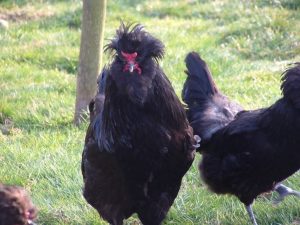 Overview
Overview
Crevecoeur Chickens are an old French breed who are related to the Houdan but have one less toe and a slightly different comb. Little is known of the origin of this breed, but it is thought that it has existed since the 18th century and was developed as a dual purpose bird.
Darwin classifies Crevecoeur Chicken with Houdans as sub-varieties of the Polish. They originated in Normandy and took their name from a village in that country.
The breed was classified as endangered in 2007, and a 1995 census of the breed estimated the population to be as little as 100 birds.
They males weigh around 6.6lbs (3kgs) and the females weigh around 5.5lbs (2.5kgs).
Eggs
Size
Medium to large size eggs
Color
White color egg
Production per year
120 per annum
When do they start laying eggs?
From 20 weeks
Crevecoeur Characteristics
Temperament / Are they good as pets?
The Crevecoeur chickens are somewhat friendly and have
How do I tame “Crevecouer” chickens?
The best way to tame chickens is to hold them when they are still young as this will help get them used to humans. For older chickens, try putting feed in your hand and letting them eat out of it.
How many do I need to buy?
You need to buy at least 2 chickens, however 6 would be a good small flock size.
How much space do they need?
They can tolerate confinement, but prefer to have lots of space to roam around in. If you’re planning on keeping them in a run you should have 25 square feet per chicken, if you want to keep them free range you need at least 250 square feet per chicken.
Will they mix with my other chickens?
Yes, they should mix well with other chickens.
Appearance
Very similar in appearance to the Houdan, only they have one less toe and a V-shaped comb. They have four recognized plumage colors: black, blue, white and cuckoo, with black being the most popular. Their legs are blue with a gray undertone. However they were and are predominately black in the US. However in 2017 blue, white and splash varieties where imported into the US from France.

Feeding
What should I feed them?
When your chickens are first hatched they should be fed growers mash which is a refined form of chicken fed with 19{cfcd481556a8b43fba6af451761032bd323e94372a0c1e607} protein, perfect for helping them grow healthily.
At 6 weeks they can have chicken pellets, which is just standard chicken feed of around 15-16{cfcd481556a8b43fba6af451761032bd323e94372a0c1e607} protein pressed into pellet form.
At 18 weeks you should slowly start introducing layers mash or layers pellets, this has around 16{cfcd481556a8b43fba6af451761032bd323e94372a0c1e607} protein and has everything nutrient wise that they need to start producing eggs.
How much should I feed them?
Your chickens ca eat anywhere between 2.9oz (80g) and 4.2oz (120g) a day each. Start by giving them ¼ of a pound (113g) and then change the amount based on how much of this your chickens eat.
Most people like to leave the feed there for the chickens to eat when they please but if you prefer you can feed them during meal times.
What can’t they eat?
There are lots of foods which shouldn’t be given to chickens, the main tow are: chocolate and beans. Chocolate has theobromine in and beans have phytohemagglutinin which can be fatal if consumed. Moldy food or food that has gone off shouldn’t be given to chickens as it can make them very unwell.
In fact, in the UK it is banned and illegal to feed your chickens leftovers from the kitchen.
What do I need to keep chickens?
The most important piece of equipment you need to keep chickens is a coop. The coop should have 1.1m2 or 11 square feet per chicken. Inside the coop you need a perch for each of the chickens to sleep on at night.
There should be wooden laying boxes as well which should have wooden shavings in them for the birds to lay their eggs in. The run needs to be 25 square feet per bird and if you would like to keep them free range then you should have at least 250 square feet per chicken.
The coop needs a sunken fence around the perimeter and over the top of it to keep your chickens safe from predators. Your water container needs to be untippable and high enough that they can’t stand in it, make sure you place it away from direct sunlight.
Make sure that there is grit always on hand for your chickens as they need this to help them make eggs.
Breed Tips
- Best and well raised on moderately dry soils.
- Seemly have more sensitive digestive systems than other breeds, and breeders did notice they were more likely to catch a cold, although nowadays they are seemingly more robust.
- In times of extreme heat or stressful situation use of probiotic could benefit the bird.
- Best suited to small areas or in confinement.
